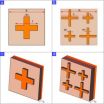(Press-News.org) After collecting weathered crude oil from the Gulf of Mexico following the Deepwater Horizon oil spill, researchers at The Institute of Environmental and Human Health (TIEHH) at Texas Tech University have reported that only 8 to 9 percent coverage on the shells of fertilized mallard duck eggs resulted in a 50 percent mortality rate.
However, scientists also reported the amount of time the oil remained at sea and exposed to weather had a significant effect on its toxicity to the fertilized duck eggs, said Phil Smith, an associate professor at TIEHH. They published their findings in Environmental Toxicology and Chemistry, the peer-reviewed flagship journal of Society of Environmental Toxicology and Chemistry (SETAC).
"If you can imagine a duck egg with about 10 percent of its surface area coated with this particular substance we found in the Gulf, you would expect about half of the bird embryos to die, according to our study," Smith said.
Because the timing of the Deepwater Horizon oil spill coincided with nesting periods for large numbers of Gulf Coast birds, Smith said researchers were interested in discovering the toxicity of the crude oil that was floating offshore and coated about 600 miles of beaches and marshlands.
Using a standardized method for examining the oil's toxicity, 160 eggs were treated with varying amounts of crude oil collected off the coast of Alabama about a month after the Deepwater Horizon oil spill.
"These kinds of studies have been conducted for about 40 or 50 years," he said. "It's not a novel or unique method for evaluating the toxicity of any kind of crude oil. What is novel about our approach is we went out to the Gulf and collected crude oil that was available during the spill. This method allowed for a realistic exposure scenario among bird eggs on the Gulf Coast during that time period. In that respect it's somewhat unique."
When compared to the toxicity of fresh crude oil from the ground, Smith found the weathered crude oil in the study ranged from 1.7 to 24 times less toxic than fresh crude oil.
"By the time that oil made it through dispersant and was transported to the coast, it had degraded significantly," Smith said. "Birds that were exposed to oil in the Gulf may have transported it back to their nests and subsequently exposed incubating eggs in nests. The weathering process made it less toxic to bird embryos. That doesn't discount the fact that the weathered oil was a significant physical hazard to the adult birds, but that wasn't the focus of our study."
Smith said about 61 percent of the treated eggs died. Among those that hatched, the researchers found no significant differences in deformities or malformations when compared to the control group.
"This study provided toxicity values for this particular oil to assist in risk and damage evaluations and reaffirmed that weathered crude oil is less toxic than fresh crude oil," Smith said. "Recent evidence in fish studies points to potential developmental effects that could result in reduced fitness traits that do not become manifest until later in life. Aside from acute lethality, it would seem important to evaluate potential for developmental or latent effects in birds exposed while still in the egg."
###
For a copy of the report, contact John Davis.
Find Texas Tech news, experts and story ideas at www.media.ttu.edu and on Twitter @TexasTechMedia.
CONTACT: Phil Smith, associate professor, The Institute of Environmental and Human Health, Texas Tech University, (806) 885-4567 or philip.smith@tiehh.ttu.edu
Deepwater Horizon crude less toxic to bird eggs after weathering at sea
Only 8 to 9 percent oil coverage on the shells of fertilized mallard duck eggs resulted in a 50 percent mortality rate
2011-07-25
ELSE PRESS RELEASES FROM THIS DATE:
Caltech-led astronomers discover the largest and most distant reservoir of water yet
2011-07-25
PASADENA, Calif.—Water really is everywhere. Two teams of astronomers, each led by scientists at the California Institute of Technology (Caltech), have discovered the largest and farthest reservoir of water ever detected in the universe. Looking from a distance of 30 billion trillion miles away into a quasar—one of the brightest and most violent objects in the cosmos—the researchers have found a mass of water vapor that's at least 140 trillion times that of all the water in the world's oceans combined, and 100,000 times more massive than the sun.
Because the quasar is ...
Penn: Nanoplasmonic 'whispering gallery' breaks emission time record in semiconductors
2011-07-25
PHILADELPHIA — Renaissance architects demonstrated their understanding of geometry and physics when they built whispering galleries into their cathedrals. These circular chambers were designed to amplify and direct sound waves so that, when standing in the right spot, a whisper could be heard from across the room. Now, scientists at the University of Pennsylvania have applied the same principle on the nanoscale to drastically reduce emission lifetime, a key property of semiconductors, which can lead to the development of new ultrafast photonic devices.
The research ...
Earliest watery black hole discovered
2011-07-25
Pasadena, CA— Water really is everywhere. A team of astronomers have found the largest and farthest reservoir of water ever detected in the universe—discovered in the central regions of a distant quasar. Quasars contain massive black holes that are steadily consuming a surrounding disk of gas and dust; as it eats, the quasar spews out huge amounts of energy. The energy from this particular quasar was released some 12 billion years ago, only 1.6 billion years after the Big Bang and long before most of the stars in the disk of our Milky Way galaxy began forming.
The research ...
Can feeling too good be bad? Positive emotion in bipolar disorder
2011-07-25
Positive emotions like joy and compassion are good for your mental and physical health, and help foster creativity and friendship. But people with bipolar disorder seem to have too much of a good thing. In a new article to be published in the August issue of Current Directions in Psychological Science, a journal of the Association for Psychological Science, psychologist June Gruber of Yale University considers how positive emotion may become negative in bipolar disorder.
One of the characteristics of bipolar disorder is the extreme periods of positive mood, or mania. ...
Farthest, largest water mass in universe discovered
2011-07-25
An international team of astronomers led by the California Institute of Technology and involving the University of Colorado Boulder has discovered the largest and farthest reservoir of water ever detected in the universe.
The distant quasar is one of the most powerful known objects in the universe and has an energy output of 1,000 trillion suns -- about 65,000 times that of the Milky Way galaxy. The quasar's power comes from matter spiraling into the central supermassive black hole, estimated at some 20 billion times the mass of our sun, said study leader Matt Bradford ...
Shining a light on the elusive 'blackbody' of energy research
2011-07-25
CHESTNUT HILL, MA (July 22, 2011) – A designer metamaterial has shown it can engineer emitted "blackbody" radiation with an efficiency beyond the natural limits imposed by the material's temperature, a team of researchers led by Boston College physicist Willie Padilla report in the current edition of Physical Review Letters.
A "blackbody" object represents a theorized ideal of performance for a material that perfectly absorbs all radiation to strike it and also emits energy based on the material's temperature. According to this blackbody law, the energy absorbed is equal ...
Life scientists use novel technique to produce genetic map for African Americans
2011-07-25
UCLA life scientists and colleagues have produced one of the first high-resolution genetic maps for African American populations. A genetic map reveals the precise locations across the genome where DNA from a person's father and mother have been stitched together through a biological process called "recombination." This process results in new genetic combinations that are then passed on to the person's children.
The new map will help disease geneticists working to map genetic diseases in African Americans because it provides a more accurate understanding of recombination ...
Cellular stress can induce yeast to promote prion formation
2011-07-25
It's a chicken and egg question. Where do the infectious protein particles called prions come from? Essentially clumps of misfolded proteins, prions cause neurodegenerative disorders, such as mad cow/Creutzfeld-Jakob disease, in humans and animals. Prions trigger the misfolding and aggregation of their properly folded protein counterparts, but they usually need some kind of "seed" to get started.
Biochemists at Emory University School of Medicine have identified a yeast protein called Lsb2 that can promote spontaneous prion formation. This unstable, short-lived protein ...
NASA catches 3 tropical cyclones at 1 time
2011-07-25
It's not often that a satellite can capture an image of more than one tropical cyclone, but the GOES-13 satellite managed to get 3 tropical cyclones in two ocean basins in one image today. Bret and his "sister" Cindy are racing through the North Atlantic, while another area tries to develop far to their south. "Cousin" Dora is still a hurricane in the eastern Pacific.
In infrared image taken on July 22 at 0845 UTC (4:45 a.m. EDT), GOES-13 captured Tropical Depression Bret, Tropical Storm Cindy in the north Atlantic and low pressure area associated with a tropical wave ...
Northwest Forest Plan has unintended benefit – carbon sequestration
2011-07-25
CORVALLIS, Ore. – The Northwest Forest Plan enacted in 1993 was designed to conserve old-growth forests and protect species such as the northern spotted owl, but researchers conclude in a new study that it had another powerful and unintended consequence – increased carbon sequestration on public lands.
When forest harvest levels fell 82 percent on public forest lands in the years after passage of this act, they became a significant carbon "sink" for the first time in decades, absorbing much more carbon from the atmosphere than they released. At the same time, private ...
LAST 30 PRESS RELEASES:
Making lighter work of calculating fluid and heat flow
Normalizing blood sugar can halve heart attack risk
Lowering blood sugar cuts heart attack risk in people with prediabetes
Study links genetic variants to risk of blinding eye disease in premature infants
Non-opioid ‘pain sponge’ therapy halts cartilage degeneration and relieves chronic pain
AI can pick up cultural values by mimicking how kids learn
China’s ecological redlines offer fast track to 30 x 30 global conservation goal
Invisible indoor threats: emerging household contaminants and their growing risks to human health
Adding antibody treatment to chemo boosts outcomes for children with rare cancer
Germline pathogenic variants among women without a history of breast cancer
Tanning beds triple melanoma risk, potentially causing broad DNA damage
Unique bond identified as key to viral infection speed
Indoor tanning makes youthful skin much older on a genetic level
Mouse model sheds new light on the causes and potential solutions to human GI problems linked to muscular dystrophy
The Journal of Nuclear Medicine ahead-of-print tip sheet: December 12, 2025
Smarter tools for peering into the microscopic world
Applications open for funding to conduct research in the Kinsey Institute archives
Global measure underestimates the severity of food insecurity
Child survivors of critical illness are missing out on timely follow up care
Risk-based vs annual breast cancer screening / the WISDOM randomized clinical trial
University of Toronto launches Electric Vehicle Innovation Ontario to accelerate advanced EV technologies and build Canada’s innovation advantage
Early relapse predicts poor outcomes in aggressive blood cancer
American College of Lifestyle Medicine applauds two CMS models aligned with lifestyle medicine practice and reimbursement
Clinical trial finds cannabis use not a barrier to quitting nicotine vaping
Supplemental nutrition assistance program policies and food insecurity
Switching immune cells to “night mode” could limit damage after a heart attack, study suggests
URI-based Global RIghts Project report spotlights continued troubling trends in worldwide inhumane treatment
Neutrophils are less aggressive at night, explaining why nighttime heart attacks cause less damage than daytime events
Menopausal hormone therapy may not pose breast cancer risk for women with BRCA mutations
Mobile health tool may improve quality of life for adolescent and young adult breast cancer survivors
[Press-News.org] Deepwater Horizon crude less toxic to bird eggs after weathering at seaOnly 8 to 9 percent oil coverage on the shells of fertilized mallard duck eggs resulted in a 50 percent mortality rate



